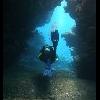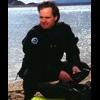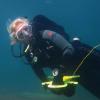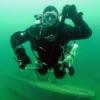I will say that Inspriations are inherently dangerous. Design flaws a many. A fatality rate approaching one percent. Cannot turn them off and fly the unit. Read the warnings in the manual and look at the CE standard that they like to say they have earned. Well CE allows for not hitting the mark if you simply state in the manual not to do the thing where the non compliance would show. So, CE mark is not a true CE mark. Also, state they were tested by the US Navy. They say this, yet fail to mention that they failed so badly that they are banned from any navy personnel every diving one again. Performance data is so bad they will not release it. Of course, since it was federal money the report is available, but they are only releasing it to sources with a need.
So, you can blame the deaths on whatever you want, but I am sure the widows of those who died would beg to differ with your defense of your investment in technology. I do not know much about the Meg, but it is also an untested unit. The problem your client had with the Topaz was something that they were supposed to check as part of their predive checklist. The elbows are removable and built to be that way. It would be understandable that it could come loose. Should have checked that prior to entering the water. So, did the diver do a predive check with the checklist as he was trained? Oh, also the no BS part is that the Topaz passed all Navy testing, through manned testing and out performed the MK16 and 15.5. Was also independently tested by DCIEM, passed there too.
I may be biased to the Topaz, but at least I can look at data that supports my bias. Kevin Gurr's unit (cannot spell the strange name) just received total pass on CE. So, I have not seen that data yet, but I imagine it is pretty good. Be interesting to compare that side by side with the Inspiration. Oh wait, I doubt they will release their data to compare. Well, sit down with the CE standard and look at the manual. Not too tough to figure out the real deal.
So, with all the noise out there and all the total fabrications about performance, I tend to lean on a company that can show me the data. So, if you plan on purchasing a unit or diving one ask for independent test data for it and to what standard it met.
The RB80 is a semiclosed RMV keyed unit. It has its own issues. DIR does not enter this conversation because they do not do closed circuit. They also have zero performance data or testing of their semiclosed. I will tell you I can imagine there can be CO2 issues with it because of counterlung design. But, they are very closed lipped, so issues are unknown for the most part. It might be okay. Problem is there is no way to know for sure without testing.
It will be interesting to see if DIR or I should say GUE become okay with CCR if they all of the sudden have a need for it in one of their projects. Hum, kind of like sidemount. Interesting. Liked Scubapro regs when they sold them, not any more now that they don't. Is it a system or a marketing campaign? Thought systems were independent of the tools they used? Well, I will leave that discussion for another time and place.
People will do what they want. I do not own a unit at the moment. Will one day. It is the future of the sport. Especially on the exploration front. But, it is totally buyer beware out there. People are more interested in defending their purchase decisions than talking real issues and problems. Do not believe the representatives of any company. Ask for performance data and testing info and demand that it comes from someone that is not tied to the company. Do a ton of homework before you invest in it.
Now, more on topic.
Closed Circuit Rebreather, CCR, is a loop that allows the diver to capture the gas that has gone through the body. We need to deal with carbon dioxide that we produce and make up for the oxygen we use with each breath.
Semiclosed, only uses one gas mixture. Some variation of nitrox. Since it is making up for the loss of oxygen by adding both nitrogen and oxygen with nitrox, it must let out gas in regular intervals. Depends on the type of semiclosed and depth of the dive as to how often that happens.
All rebreather, regardless of type, have to scrub carbon dioxide. The scrubber is what limits your duration underwater. You can always plumb in more gas. The reaction to scrub carbon dioxide is accomplished with the use of sodium hydroxide, effectively. There are other trace items in there. This reaction produces moisture and heat. So this leads to one of the benefits of rebreathers. The breathing mixture is warmer and moister. So, you do not get as cold and the cotton mouth is gone. Not a bad thing by any means.
The real advantage with CCR is having the gas duration of the unit at any depth. Because oxygen use is based on the bodies metabolic rate, it only has to be replaced in small amounts. The body does not use more at depth as we do on OC. It is based on the workload the diver is faced with. So, we still have to deal with our inert gasses, meaning we have to decompress or track no stop times, but if we have a six hour duration that is six hours to whatever depth the unit is capable of going and the diver is trained to do.
The other advantage is that the unit is at a constant PO2. Unlike OC nitrox where we have to track PO2 and have maximum depths we can dive. On CCR you can pick and fly any PO2 you like. So, as soon as we dive multilevel, we begin to breath richer and richer mixtures of nitrox as we progress to shallower depths. So, you end up, with the right planning, with the ability to dive no stop for as long as anyone would possibly want to stay in the water. It is real freedom. Only come up when you want to.
The disadvantages are that it does require training. The courses should be four or five days at least for CCR. No amount of OC experience translates to CCR, so forget about jumping out of class and going right to where you were on OC, especially tech divers. If you cannot program a VCR, CCR diving is not for you. CCR diving requires an awareness and mindset of checking things regularly. The cost of the unit is generally expensive, but if you own top of the line OC gear, you have probably spent more than CCR costs. Once you are dialed in, the pre and post dive routine does not take that long. Maybe twenty to twenty five minutes on predive and post dive maybe fifteen or twenty. This is of course only at the beginning and end of the day. If you are diving several times in the day there is alittle bit to do between dives, but much less that an OC diver has to when refillling cylinders and such. The CCR diver can get back in anytime they want.
The main thing to keep in mind is that on OC when something goes wrong with gear, you know it right away. On CCR, because you are rebreathing your own gas, if you do not pay attention or you become complacent, you can happily keep breathing till there is no oxygen left to breath. There are some other issues that are covered in a good course.
All of this is monitored by three sensors. Three so you have a true voting system, if a sensor should fail. These sensors send information to a computer about oxygen PO2. Then the computer automatically adds oxygen as needed to make up for the use. The CO2 scrubbing is a passive thing. Gas passing through material.
So, CCR can be awesome. I recommend that you do your homework.
Pick a unit that has these things.
Independent testing to a measurable standard that you can easily compare. Demand the data.
You can continue to dive in closed circuit mode with no power to the unit. Fly it shut off and stay on it in CCR mode.
Has a true secondary display that is powered by sensor output. Not what is essentially another primary.
Does not want to recalibrate with 100 O2 if turned off when at depth and then will auto inject pure oxygen into the unit. The unit should know it is diving.
Has tested performance that matches your demands for the unit.
Scrubber design that matches the depth you plan to eventually get it to. Well times are critical. Always ask at what workload and temperature the duration was tested at. Because it is longer the warmer the temperature and the lower the CO2 load.
The weight and configuration meets your needs. Not all CCRs are heavy.
The performance data meets your needs.
Do not train with someone on CCR that
Makes promises that seem too good to be true.
Offers short or free classes.
Is the same person that sells you the unit. It is a conflict of interest that can lead to them being far less open about potential problems than someone that does not care if you return the unit.
Does not train for unit failures or suggests that very little or nothing can go wrong.
That tells you CCR is just like OC.
Has a less than serious attitude toward your safety on the unit.
Anyone that suggests you just trust the unit.
Anyone that cannot backup any claim about performance or safety with independent data.
That offers a course shorter than four very long days or five more normal ones, if not longer.
That suggests you can take your new CCR right back to where you were diving trimix with OC tech dives right after your entery level course.
Anyone that does not suggest working to depth slowly.
Anyone that suggests you can immediately do other things while diving the unit after the course.
CCR is its own mindset. Approaching CCR with an OC mindset that you just hookup the unit and away you go is dangerous and you want to stay away from them.
CCR is a wonderful tool. It is very useful for the recreational diver that wants to gain a lot of bottom time, but the cost is you have to learn how to survive on the rebreather. You do not learn how to dive on them, you learn how to survive on them. They do not fail often, that is why it is important to have a how can this fail mentality. The design and performance of the unit is what is going to help you solve those problems in the rare event they occur. Your training is the foundation that is going to allow you to use that tool.
I do not want to scare you out of trying rebreathers or buying them. Just be smart about it.
My long two cents. M you sure you wanted me back. LOL
Grant
Edited by bigblueplanet, 18 November 2004 - 11:39 PM.



















